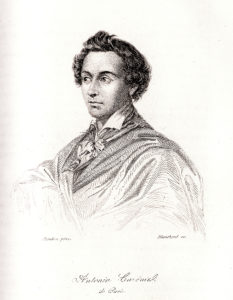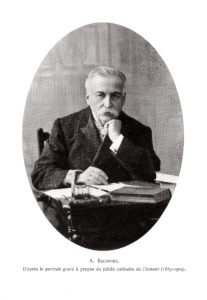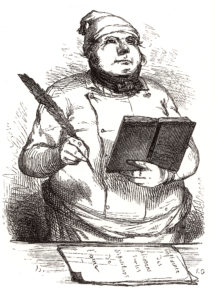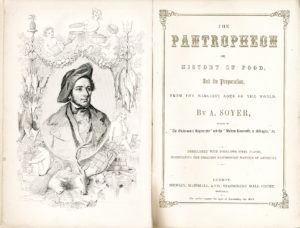By Michael Garval (Regular Contributor)

Fig. 1: Auguste Blanchard II, Antonin Carême (1833)
Chefs as Writers
Early celebrity chefs were haunted by their collective past, by centuries of domestic service. Fleeing the ignominy of their profession, they coveted the prestige of literature. So in portraits they rarely wore chefs’ garb, and instead posed as writers.
Perhaps the first celebrity chef, Antonin Carême (1784-1833) was the subject of flattering portraits. Some surround him with writerly trappings–pen, books, desk–and foreground his writing hand. Others, like Blanchard’s engraving (fig. 1), feature unruly hair, swirling drapery, dark eyes, and a broad thinker’s forehead. Carême appears a Romantic genius, like Lord Byron, or a young Victor Hugo.
Portraits of the great Auguste Escoffier (1846-1935) likewise present him not as a chef, but as a distinguished man of letters. In a frontispiece portrait commemorating his culinary silver jubilee (fig. 2),

Fig. 2: Frontispiece portrait, Auguste Escoffier, Les fleurs en cire (1910)
light illuminates his head. The usual writerly paraphernalia–pen, paper, inkwell, books, desk–occupy the foreground, with the dark paneling of his study behind. Escoffier ponders his next sentence, left hand against his chin, supporting the repository of his intellect. His right hand is poised, not to skim stock, but rather to transcribe his lofty thoughts.
Literary Imposture
Such pretensions were satirized broadly. In one illustration (fig. 3), the would-be cook of letters wears an ill-fitting uniform accentuating his prominent belly. Light shines upon his powerful jowls, rather than forehead, with his toque pulled low for a more Neanderthal effect. These details emphasize ingestion and digestion rather than higher cerebral functions.

Fig. 3: Bertall, illustration for Eugène Briffault’s Paris à table (1846)
Yet this dimwit aspires to literary grandeur. His pudgy face gazes outward, aping pensive attitudes struck by chefs like Carême. He holds a book and oversized pen awkwardly, composing a learned treatise on the “Influence of foodstuffs upon the dispositions of the soul.” But the manuscript lies perpendicular to him, an impossible angle for putting pen to paper. Such an oaf writes badly, or just doesn’t know how.
The gap between this chef’s literary ambitions and real abilities might seem preposterous. But it actually recalls the case of Alexis Soyer (1810-1858), the top French chef in mid nineteenth-century England.
In his ambitious but ghostwritten Pantropheon, the barely literate Soyer trumpeted his ostensible literary prowess. An elaborate frontispiece (fig. 4) surrounds his portrait with a grandiose allegory of food, and food writing. Below, alongside running water, tilting books marked Homer, Virgil, Horace, Ovid, Pliny, and Apicius spill over into the text ahead.

Fig. 4: Frontispiece, Alexis Soyer, The Pantropheon or, the History of Food, and Its Preparation, from the Earliest Ages of the World (1853)
Placing Soyer in this impressive lineage, the frontispiece vaunts his supposed expertise, authority, and stature as a writer. But such bogus claims also reveal the scope of his literary imposture.
Writers as Chefs
Nowadays culinary work, like cooking in general, enjoys unprecedented cachet. Freed from earlier stigmas, today’s high profile cooks embrace their professional identity. Whether in photographs, advertisements, food shows, documentaries, or websites, they sport chefs’ uniforms, flaunt knife skills, and showcase signature recipes.
Tables have turned. Where chefs once posed as writers, they now pose as chefs. In a revealing twist, writers also get cast as chefs. And this becomes apparent through one current trend in particular.
Literary foodbooks have abounded in recent years. These popular volumes highlight noted authors’ recipes and gastronomic musings, recreate dishes from their works, evoke meals from their period and milieu, and depict key elements in their gastronomic universe (kitchens, dining rooms, favorite restaurants, etc.). Some, like The Pat Conroy Cookbook, look at contemporary writers. But most, like Anne Borel’s Proust, la cuisine retrouvée, focus on canonical figures from the past two centuries. They hark back to a time when the realm of letters still offered chefs a shining if unattainable ideal.
Today however, foodbooks are turning literature into a vast smorgasbord, a delightful gastronomic romp. Authors, no longer the cultural beacons of yore, get rehabilitated as inspired cooks and enlightened eaters, whose culinary creations and diets somehow exemplify their special sensibility and personal magnetism.
Chefs once cloaked themselves in the flattering guise of literature. With the relative decline of literary culture, and concurrent rise of food culture, the landscape has shifted. Now writers bask in the newfound luster of the kitchen.
